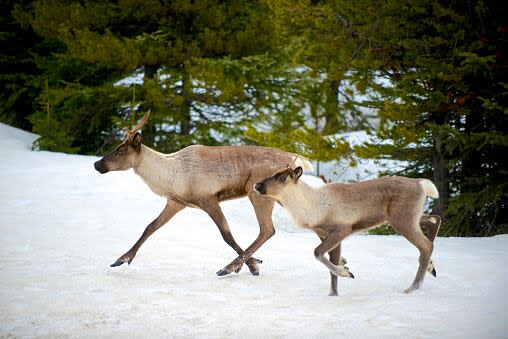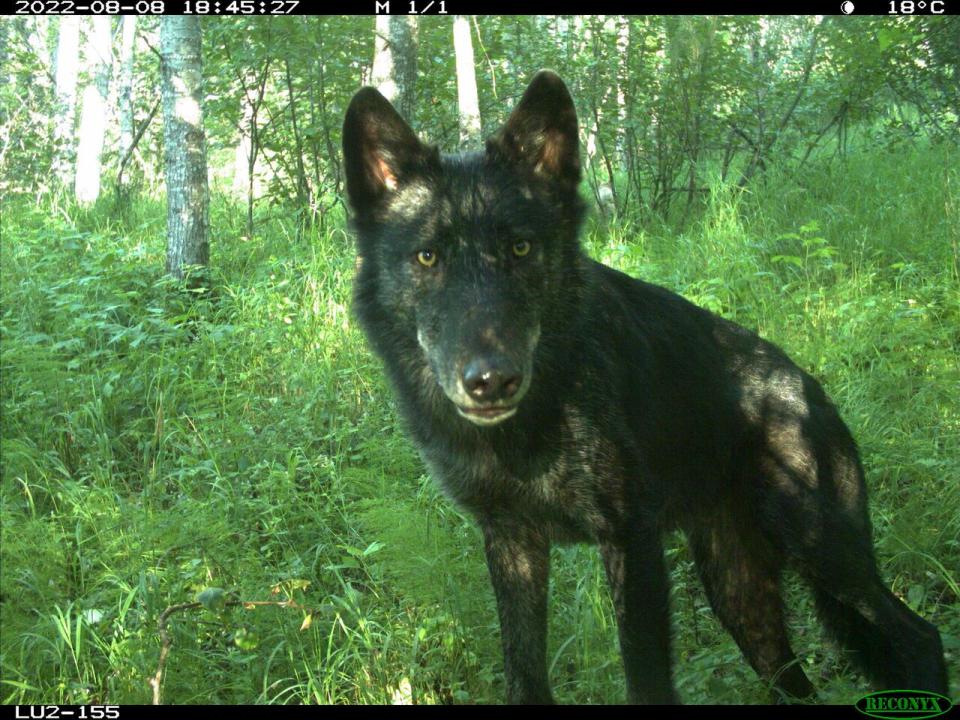Culling wolves alters the survivors and that could be 'bad news' for caribou, study finds
When wolves are killed by bullets fired from helicopters during Alberta government culls, surviving members of the pack quickly learn to evade the threat, a new study has found.
For nearly two decades, Alberta has killed off hundreds of grey wolves each year in an attempt to bolster dwindling caribou populations, a practice critics have described as a misguided measure to help herds on the brink recover from habitat loss.
New research sheds light on how the practice alters the surviving wolves and warns of unintended consequences on threatened caribou and the broader boreal habitat.
Researchers at the University of Victoria and the University of British Columbia tracked the movement of wolves in a vast stretch of northeastern Alberta before and after a cull.
They found that culls alter the behaviour of survivors by pushing them deeper into the forest to new hunting grounds — changes that may help caribou in the short term but could ultimately help wolf populations quickly recover from a slaughter.
"Caribou aren't being preyed upon as often, and that, hopefully, will let them get their hooves under them and recover," said Jason Fisher, a wildlife scientist at UVic's School of Environmental Studies who co-authored the study.
"But wolf populations could rebound much more quickly than we think. And if they do rebound quickly, then that's bad news for caribou."
The study, published this week in the journal Biological Conservation, also found that killing off wolves in large numbers triggers changes in how the animals move across the landscape.
That could have ripple effects on predator and prey species throughout targeted forests.
Alberta has relied on wolf culls since 2005, often shooting the animals from their air as a way to stabilize caribou populations suffering from habitat loss.
In 2022 and 2023, more than 500 wolves were destroyed in caribou ranges across the province. Government officials did not respond to CBC requests for comment on its wolf management program.

Fisher said the paper is the first "before-and-after" study of its kind but shouldn't be the last.
As culls continue, investigating how surviving wolves react is critical to caribou conservation and the well-being of targeted habitats, he said.
Fisher said culls could set off a chain reaction in the way an ecosystem functions, or create an unexpected imbalance in the food chain as wolves compete with other predators for food.
But our understanding of these possible "butterfly effects" is limited, he said.
"We don't know what happens to wolves long-term after we stop pulling the trigger."
Devon Earl, an ecologist and conservation specialist with the Alberta Wilderness Association, said the study illustrates problems with the provincial approach, and how targeting a keystone species can have harmful, cascading impacts.
She said culling is a costly and ineffective solution that ignores the urgent need to restore critical caribou habitat.
The research is a reminder that killing wolves will not save caribou but merely props up their populations, Earl said.
"It's a Band-Aid approach," she said. "We don't want to rely on this in perpetuity."
From predator to prey
In the study area, stretching across 3,500 square kilometres of boreal forest around 350 kilometres northeast of Edmonton, culling began in 2016.
Caribou populations in the area, in the Cold Lake and Athabasca River ranges, have been in decline since 1999 when government monitoring began.
The government relied on aerial gunning by helicopter in winter to target the area. Between 2017 and 2020, 92 wolves in the region were killed. The target was to reduce the local wolf population by 95 per cent.
Alberta's aerial gunning program relies on a combination of snow tracking and what are known as "Judas wolves," radio-collared animals that guide shooters to the pack.
The open landscapes that wolves prefer lend themselves to aerial tracking, allowing shooters to easily find their targets.
Researchers used a grid of remote infrared digital cameras to track wolves before and after the hunt.
Between October 2011 and October 2014, camera traps operated across 61 sites. After the cull, between 2017 and 2020, researchers again deployed the cameras to keep watch on the wolves.

When the predators became prey, the animals quickly adapted. Wolves became more nocturnal and moved deeper into the forest, learning to fear their usual hunting grounds, the study found.
"I mean, if you suddenly had a big avian predator that's really loud and screaming down at you and can kill you from afar, that's a good place to stay away from, right?" Fisher said.
"The fact that they adapted to this aerial gunning so quickly shouldn't have been a surprise, but it's still very remarkable."
Wolves usually prefer to travel along easily travelled, linear features on the landscape such as seismic lines, trails or logging roads.
Following a cull, wolves avoided these areas, preferring to stalk their prey in what are known as block features such as cutblocks and well sites, where they could find patches of open vegetation deep in the forest.
Fisher said these patches of land provide an abundance of prey animals, but wolves could be pushing other predators out of these more secluded hunting grounds.
Pushing wolves off the open tracks and trails they prefer means the animals would be harder to find during future culls, he said.
He said it's unclear how long wolves would remain fearful of certain features on the landscape, or if they would pass these lessons along to their young.
Fisher said culling has been necessary to save critically low caribou populations, but criticism of the program is justified. Predator control remains a primary strategy in wildlife conservation despite a lack of long-term research, he said.
The government needs to commit to monitoring both the expected — and unexpected — consequences of killing wolves, he said.
"Then you can make some informed decisions instead of guessing."

 Yahoo News
Yahoo News 
